Scotland’s biggest teaching union has called for schoolchildren to be taught at home in areas subject to the toughest coronavirus restrictions.
The Scottish Government wants schools to remain open “if at all possible” even in regions on highest alert in the new five-tier system to come into force on Monday.
However, the Educational Institute of Scotland insists that remote or blended learning – where pupils attend school part-time and learn at home – should be required in tier four.
Local tiers
Dundee could be moved up to level three of the tiers, to be confirmed on Thursday, with Fife, Angus and Perth and Kinross expected to be in level two.
In the government’s determination to keep schools open it appeared it regarded teachers as expendable, the EIS said.
Larry Flanagan, general secretary, said: “Schools cannot be kept open at any cost.
“They cannot be kept open at the expense of the safety of teachers and of other school staff.”
The EIS wrote to Education Secretary John Swinney and education spokespeople for all political parties ahead of the Scottish Parliament debate of the tier system on Tuesday.
‘Teachers seen as expendable’
In his letter Mr Flanagan stated: “The EIS shares the ambition for schools to remain open wherever possible, as long as this can be done safely for both pupils and staff.”
But he continued: “Concerns have deepened considerably as the level of community infection has risen sharply.”
He said: “It very much appears to our members that the government has made a political priority of keeping schools open and in that calculation, teachers can be regarded as expendable.
“In particular, the default position at level four that schools are fully open when clearly we need to be looking at blended or remote learning as contingencies, seems to the EIS to be predicated on political messaging rather than controlling the spread of infection.”
School closures elsewhere in UK
Citing full and partial school closures in Wales and Northern Ireland and significant work already done by Scottish schools to prepare for blended or remote learning, Mr Flanagan added: “The EIS believes that the deployment of blended or remote learning contingencies should be cited, as a minimum, as required interventions at level four of the framework.”
During the debate, First Minister Nicola Sturgeon said: “Under all five levels we want schools and childcare to remain open if at all possible.”
‘Evidence needed’
Scottish Greens co-leader Patrick Harvie highlighted the EIS’s concerns and also pressed for publication of evidence for keeping schools open at level four.
He said: “We know that, across the country, social distancing is not happening in schools and teachers are deeply concerned that their health is being put at risk in confined spaces.
“The restrictions at level four of the new system are parallel to those that, in many other countries, including other nations in the UK, are triggering school closures.
“I agree that we should try to avoid school closures if at all possible and keep schools open if it is safe to do so, but teachers, as well as pupils and families, need to have clarity about what the conditions would be in the future if closures, even for short periods of time, became necessary.”










